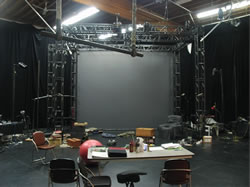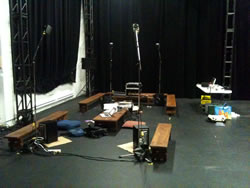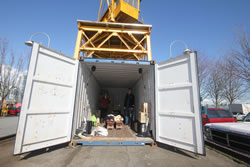Integrating Electroacoustic Techniques into Theatrical Performance
I have explored various methods of theatrical sound design as Technology Director with Boca del Lupo since 2009. I have worked intensively on more than 40 projects, from small-scale productions such as an audience of one inside a phone booth to large outdoor spectacles with an audience of hundreds surrounded by shipping containers stacked four storeys high. Since 2002, I have been attempting to create a meaningful, collaborative method of integrating electroacoustic techniques into theatrical creation. Specifically, I am using spatialization, timbral modification and other electroacoustic composition techniques within the context of a theatrical development, rehearsal and performance process.
As each of the sound designs I created were made for a specific theatre production, I did not want to simply hand over a design to a director and receive feedback. I wanted to be able to manipulate and create the sound design in response to what was happening in the rehearsal room. This motivation comes from a desire to play. I have a strong improvisational background from my studies in music, and most of the theatre I have worked on has used a devised theatre practice. In this practice, performance is created or “devised” by collaborators working through ideas in a room, as opposed to working from a fixed script. 1[1. See Barton et al. 2008 for information about devised theatre.] This is one method that Boca del Lupo uses regularly in its creation process.

My early forays into using electroacoustic techniques with theatre were frustrating and difficult, as I found that the two creative processes moved in very different rhythms. Electroacoustic composition is usually created in a specialized sound studio, solitarily and with an individual creation timeline. It is very detailed work with much revision of minutiae and often involves creating a unique musical language for each individual piece. Conversely, theatre is highly collaborative and requires a cross-disciplinary language. Also, one needs to be ready to work on a fixed schedule where the focus of the rehearsal is often not on the sound design. Most importantly, sound designers need to have a working method that is fluid and flexible enough to adapt to the myriad changes that occur as a performance develops with the director, actors, designers and all of the production elements.
Selected Boca del Lupo Projects
Four works I was involved in creatively since 2009 at Boca del Lupo can serve as examples to illustrate my journey towards a successful integration of electroacoustic techniques into theatrical performance.
Photog (2010)
Photog was the first project I worked on with Boca del Lupo from start to finish. I was involved in technical workshops on lighting, video, sound and stunt rigging. In addition to normal theatrical practices, the production involved live-feed video, live music, microphones, recorded sound and stunt rigging. During the performance, the video operator, sound operator, rigger and musician were on stage with the solo performer. For this production, we integrated lights, sound, music, stunts, live video and recorded video. We were fortunate to be able to spend two months in studio creating the show with almost all of the necessary technological elements constantly at our disposal. Initially, we wanted to have surround sound using four or more speakers, but as we began working with all the elements of the show, it became overly time-consuming for me to integrate surround sound with all the other elements.

At the time, I was using a Max patch to spatialize the sound, and Ableton Live to play cues and to monitor microphones and levels of the live musician. Every cue change or shift in the development of the show had a ripple effect on video, music, sound and action. My attempts to integrate spatial sound with a separate software into the mix took too much time away from more essential elements of the design. My setup needed to be more responsive to the changes occurring in the room during the creation process. So, I abandoned the planned ideas about spatialization for this piece, removed the Max patch and refocused my efforts on integrating the live music, microphones and sound cues. The result was a very strong integration of not just the sound design components of the work, but all technologies used in the performance. Although Photog subsequently received an award for technical integration, my inability to incorporate spatialization left me with an itch I could not scratch until the next opportunity came around.
The Voyage (2012)

The Voyage was a Boca del Lupo creation. The sound design was the result of a collaboration between Jean Routhier and myself; Sherry J. Yoon directed the work and Jay Dodge worked on the overall design. The audience met in a small room, up a small flight of stairs, in a small building under a bridge. Once the audience of 14 was gathered, they were taken down the stairs and outside to a waiting unmarked van. They were escorted inside and the doors were closed. They were driven in complete darkness while they heard a radio station playing something reminiscent of a place far away. The van backed up a ramp, stopped, the doors opened and the audience was escorted into a shipping container. They sat down on two long benches in the centre of the container, and then the doors were closed and locked. That is when the “voyage” began. It was approximately ten minutes in duration, and was an imaginary voyage across the Pacific Ocean in a shipping container. At the end, the doors were opened and the audience was released into the night.
Initially, Jean and I made recordings of the shipping container and then did a series of improvisations in the studio (Fig. 3). The result was an abstract electroacoustic score with some recognizable elements from the recordings — combinations of spectral transformations and musique concrète. Sherry listened to our improvisations and then suggested a narrative approach, using our improvisations to colour a more literal sonic journey across the ocean. We then created what became the final composition, which took the audience on a recognizable journey within the container (Fig. 4) from a dock somewhere in Asia, across the Pacific and to their final “destination” in Vancouver.

Working with Sherry, a theatrical director, to create a musical composition resulted in something neither of us would have made in isolation and took all of us in directions we would not have gone alone. Our composition became more narrative and our sonic palette more recognizable. Almost all of those who attended the performance had never heard of electroacoustics, but all of those who attended were very taken by the sonic elements of the show.
This was the first time I felt that electroacoustic techniques were technically and æsthetically integrated into the performance. We were all very happy with the outcome. It was produced twice in Vancouver and a variation of the composition ended up in another Boca del Lupo production, Fall Away Home (also discussed below).
The integration was successful but very specific to this project. Going forward, I wanted to make a system that could be adapted to various projects — I would not always have the luxury of months or weeks in a rehearsal and creation process as we had with The Voyage. I discuss the technical details in the next example, as the technical developments I made for The Voyage were idiosyncratic.
Realwheels (2013)


The next time I had an opportunity to explore integrating electroacoustic techniques into theatre was in a project with Realwheels, a Vancouver-based theatre group that questions and challenges the attitudes and barriers often experienced by people with disabilities. This project was a site-specific performance in Vancouver’s Blusson Spinal Cord Centre involving stories told by performers with self-identified disabilities. They told the stories through song, dance, monologues and multimedia presentations. There was live music, wireless mics, video and recorded sound.
I began with the same Max for Live patch I created for The Voyage. I adapted the SendsXnodes.amxd patch that comes with Max for Live to create a custom 8-channel sound system. 2[2. The adapted patch for 8-channel spatialization can be downloaded here.] It was essentially a cube, allowing the sound to be placed in three-dimensional space and to remain in sync with any changes made to the sound design in Ableton Live (Figs. 5 and 6). During the opening number, the performers had a choreography that took them up a ramp around the audience, and the sound of their voices moved through the sound system, following them. Various sound effects came from above or below depending on the nature of the sound and the story being told. 3[3. The adapted patch for vertical spatialization can be downloaded here.] With everything happening in one piece of software, I was able to make edits to sound cues as well as spatialize sound in response to the action of the performance. We had one day of tech before presenting the work, therefore speedy and solid adjustments were essential.

The integration of spatial sound and the facility to change cues quickly was successful, but there were some basic elements, such as monitoring for the live performers, that were problematic. That is, with all the outputs for the multi-channel environment, I ran out of outputs for proper stage monitors for the musicians. It was a “two steps forward, one step back” moment, but something that could easily be remedied for future projects. Overall, the system held up to the stresses of a complicated site-specific live performance, and I further refined this setup for future projects. In fact, it is this system with small improvements and show-specific adaptations that I continue to use today.
Fall Away Home (2013)
Fall Away Home was a large site-specific outdoor production that took place in Stanley Park in 2013. It involved song and dance, a large cast, 16 shipping containers, 40-foot projections, 4-channel sound, an audience capacity of 400, contraptions and more. 4[4. Project documentation for Fall Away Home is available in the MediaLab section of Boca del Lupo’s website.] This project was the first time I felt that electroacoustic techniques were successfully integrated throughout the creation process. An interesting note is that we essentially had two sound designers on the show as well as recorded music. The recorded music came from Bell Orchestre, a six-piece band from Montréal, and Vancouver-based composer, violist and laptop artist Stefan Smulovitz worked on the sound design content as well as on more specific compositions directly related to the show. I worked on the integration of the sound into all the elements of the show: video, vocal effects and 4-channel sound in the site-specific location.
Following the culmination of experience from previous projects, with Fall Away Home we were able to integrate electroacoustic techniques right from the beginning. In the rehearsal room I was able to quickly draw from the music and content, and adapt it to the changing vision of the show. I was able to shift and morph the beautiful music of Bell Orchestre to fit the tempo and timeline of the action. Ableton Live’s strong real-time stretching and syncing, as well as easy connectivity to controllers, made it simple for me to adjust the music to the action. For example, I was able to match the tempo of a dance number where the performers suddenly began to dance in slow motion.
In another scene the main character was transformed into a fish, and the audience became the ocean around her. She was harnessed into a contraption, which tipped her above and below the heads of the audience as it moved through the crowd. It was simple to trigger the sound of splashes as she entered and exited the “ocean”, and I could place the splashes in space simply by turning one knob.
Another scene began with loud and exciting music. Two large contraptions called “kid pickers” came into the audience to “steal” children and bring them on stage where they were “sold” back to their parents. The contraptions moved through the audience in large arcing movements and were periodically stopped by the auctioneer so he could examine the “specimens”. When the auctioneer spoke, I swept in a low-pass filter, bringing down the high frequencies as well as panning the music through the speakers, mirroring the movements of the contraptions. It heightened the feeling of movement and disorientation the contraptions brought into the space. Where were they coming from? Would they pick my child next?
The video elements were created simultaneously with, and in relation to the live action. The animator we worked with was in a room just outside the rehearsal hall, madly creating animations. I was able to add sound design, Foley and music all within Ableton Live, so there was no process of creating, rendering, integrating and editing; it was all folded into one seamless process.
The moment in the show that tickled the electroacoustician in me the most was when the audience put on blindfolds and listened to a three-minute sonic journey across the Pacific Ocean, which in another context might be perceived as an acousmatic concert.
From start to finish, working on this project was fun and productive, and we were able to integrate electroacoustic techniques seamlessly into the rehearsal and creation process. So much so that Sherry, the director, described it as being the first time she would ask the technology to change as opposed to the actors, because the sound and video were easier to change than blocking or choreography.
Conclusion
The question I struggle with in this journey is how to integrate sophisticated electroacoustic techniques without succumbing to complexity that bogs down artistic collaboration. Sure, there are times when I wish I could spend hours or days on a particular sonic gesture; mapping its motion through space with spectral morphology extraordinaire, but at the same time I want to be present in the room with my collaborators, and a good improviser has to be able to listen and respond in a timely manner. By becoming proficient with and adapting tools like Ableton Live, I feel I can now bring my electroacoustic palette to collaborations with a broad range of artists in a meaningful, responsive and playful way.
Bibliography
Bruce, Barton, Natalie Corbett, Birgit Schreyer Duarte and Keren Zaiontz (eds.). Canadian Devised Theatre: Reluctant texts from exuberant performance. New Canadian Drama: Volume 9. Ottawa: Borealis Press, 2008.
Smulovitz, Stefan. Kenaxis. http://www.kenaxis.com
Wikipedia contributors. “Devised Theatre.” Wikipedia: The Free Encyclopedia. Wikimedia Foundation Inc. http://en.wikipedia.org/wiki/Devised_theatre
Social top